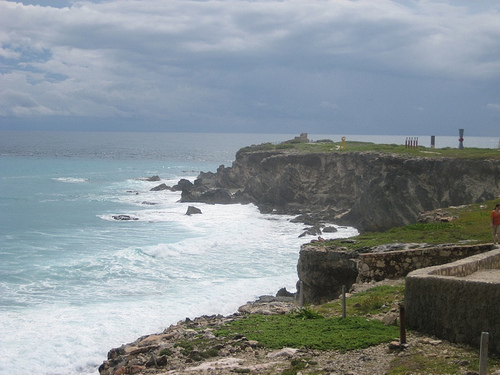Commentary: The Quest for the Perfect Cigar
7 Nov 2011
The quest for the perfect cigar does not always end in riches, but sometimes the accomplishment is in the journey itself. I rolled into Mexico last week with my wife and a couple of friends for eight days of R&R at a resort on the island of Isla Mujeres, off the coast of Cancun. Being in a tropical paradise and a country where Cuban cigars are legal, I obviously set out to find the perfect cigar. In the end, it was the experience of the adventure and the search for the cigar that yielded more enjoyment than the cigar itself.
The first stop was the duty free-shop in the Cancun airport. I encountered the usual Cuban staples: Partagss, Montecristo, Romeo y Julieta. Three-packs and five-packs, most in the $50 to $100 range. A total rip-off. Are they even real? They had the hologram and the seal from Habanos, but I knew those were easy to fake. I decided to give it a chance though— given that I was in a duty-free shop and not talking to some vendor on the street, I figured the odds were slightly in my favor. I bought a three-pack of Romeo y Julieta No. 5 cigars for $25.
Motioning for the attendant to unlock the glass case, he smiled and asked, “¿Habla Español?†I held my thumb and forefinger an inch apart. “Un poquitito.†Just a tiny little bit. “¿De donde?†He asked. Where are you from? “Minnesota.†“Ah,†he nodded. “Venezuela.â€
“No,†I waved a hand. “Mnnesota.†I pointed to my baseball hat and quickly realized I’ve just pointed to the red and white Minnesota Twins TC embroidered on my hat, surely confusing the poor gentleman. He’ll never connect TC to Minnesota, I thought, so I quickly explain, “The Twin Cities.†He nodded and smiled and I’m not sure how much he understood, or how much he cared, because the next thing he did was point me to the cash register. I paid for my three-pack and the girl bagged my stogies in plastic and secured them with a twist tie. I passed through customs and an hour later, my party and I were on Isla Mujeres.

I knew the island would be filled with cigars and vendors pushing them on every corner and after five minutes I knew that even if these Cubans were real, I wouldn’t want to touch them. The vendors cared for their cigars the same way I care for my dirty laundry. If there was a bin they could have used to toss these cigars in for their store for display, they would have used one. I saw boxes of cigars arranged outside on the steps leading into a shop, probably boiling to death under the 90-degree sun or sopping under the 90-percent humidity. I saw wrappers cut and wrinkled like the cigar had been carried in someone’s pocket. I saw gnarly, makeshift variety-packs where a Cohiba shared a box with a pair of cheap Montecristos and a handful of nameless mix-and-match cigarillos. The prices weren’t bad but these cigars were so unattractive that I was happy I brought a six-pack of Sancho Panza Double Maduros from home.
I shared the Romeo y Julietas with the couple we traveled with, giving one to the husband, another to the wife, and keeping the third for myself. This would be the first cigar either of them had smoked and they needed a quick seminar. I cut their ends and demonstrated how to light it, and how to puff on the stogie. “Don’t pull too fast,†I warned them. “You don’t want to hotbox it.†“Do I inhale?†asked the wife. “No,†I said. “Just enjoy the taste.â€
We sat on a cliff overlooking Mexico’s easternmost point, watching and listening to the waves, smoking Cuban cigars. After 15 minutes of peace and solitude unknown to the American hustle-bustle, it was time to move on. “How do you put it out?†they asked.
“You don’t,†I told them as I gently placed my smoldering nub on the edge of the cliff. “Just let it go out on its own. Respect the stick. Leave it here, and let it be.†They did, and we walked back to our golf cart and began the journey back to our hotel.
On the way back we passed a small baseball stadium with a capacity of probably 5,000. There was a bronze statue of a baseball player outside but we passed it too quickly for me to read the name. Then I realized, they have their own baseball heroes in Mexico. Their own great games, their own legendary moments. Mexican baseball was a whole new universe, and one where I could happily spend a lifetime.
When we got closer to our hotel, the vendors appeared with their calls to Cuban cigars. But aside from the Romeo y Julietas, the Sanchos were all I smoked. Sure, the vendors are constantly pointing to their, “Cigars! Cuban cigars!†They think that since you’re a guy, you’re going to jump all over them but these guys are clearly marketing to the cigar-ignorant, and based on the volume of product available, this is a market that thrives.
Sadly, I never found the perfect cigar. Sure, the cigars from the airport were good, but I was hoping to try an authentic Cohiba Behike. All I encountered was the bottom of the bargain bin. As I stared into the blue water I realized that every quest does not end in glory, especially the quest for the Holy Grail. My crusade would have to continue on another trip, to be resumed on my next journey overseas. Until then, I could only relish in the excitement of the search and the anticipation of another adventure.
–Mark M‘s latest project is a comic anthology called Germ Warfare.
photo credit: Stogie Guys


 1) The House of Representatives bill to protect premium cigars from regulations imposed by the U.S. Food & Drug Administration (FDA) has broken 100 cosponsors. At least 102 representatives from
1) The House of Representatives bill to protect premium cigars from regulations imposed by the U.S. Food & Drug Administration (FDA) has broken 100 cosponsors. At least 102 representatives from  When Crémo actually hits the market in early 2012, Santiago will be promoting the fact that the cigars are crafted at the El Titan de Bronze Cigar Factory on Miami’s Calle Ocho. The factory, according to a recent Crémo press release, is “known best for its old-school Cuban entubado techniques, [and] is a family owned and operated ‘fabriquita’ which employs level-nine rollers from Cuba, who have worked for Cohiba, Romeo y Julieta, Corona, and Partagas. These torcedores, like a painter to a canvas, handcraft each cigar with meticulous detail.â€
When Crémo actually hits the market in early 2012, Santiago will be promoting the fact that the cigars are crafted at the El Titan de Bronze Cigar Factory on Miami’s Calle Ocho. The factory, according to a recent Crémo press release, is “known best for its old-school Cuban entubado techniques, [and] is a family owned and operated ‘fabriquita’ which employs level-nine rollers from Cuba, who have worked for Cohiba, Romeo y Julieta, Corona, and Partagas. These torcedores, like a painter to a canvas, handcraft each cigar with meticulous detail.â€
 I’d smoked several of the
I’d smoked several of the 
 Ask any cigar enthusiast to name his top three cigar brands, and there’s an excellent chance Padrón will be one third of his answer. This vertically integrated company has been in the business for almost 50 years, and it has produced some of the most sought-after cigars this side of Cuba—including the Anniversary Series (both 1926 and 1964) and Family Reserve.
Ask any cigar enthusiast to name his top three cigar brands, and there’s an excellent chance Padrón will be one third of his answer. This vertically integrated company has been in the business for almost 50 years, and it has produced some of the most sought-after cigars this side of Cuba—including the Anniversary Series (both 1926 and 1964) and Family Reserve.
 Patrick Ashby
Co-Founder & Editor in Chief
Patrick Ashby
Co-Founder & Editor in Chief Patrick Semmens
Co-Founder & Publisher
Patrick Semmens
Co-Founder & Publisher George Edmonson
Tampa Bureau Chief
George Edmonson
Tampa Bureau Chief